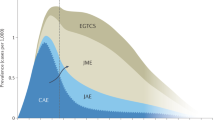Abstract
Prader–Willi syndrome is a multisystemic genetic disorder that can be associated with epilepsy. There is insufficient information concerning the clinical and electroencephalographic characteristics of epilepsy and the long-term outcome of these patients. The aim of this study is to describe seizure types, electroencephalographic patterns and long-term seizure outcome in Prader–Willi syndrome patients suffering from epilepsy. We retrospectively studied 38 patients with Prader–Willi syndrome and seizures. Results of neuroimaging studies were obtained for 35 individuals. We subdivided these patients into two groups: group A, 24 patients, without brain lesions; and group B, 11 patients, with brain abnormalities. All patients were re-evaluated after a period of at least 10 years. Twenty-one patients (55.2 %) were affected by generalized epilepsy and 17 patients (44.8 %) presented focal epilepsy. The most common seizure type was generalized tonic–clonic seizure. The mean age at seizure onset was 4.5 years (ranged from 1 month to 14 years). In the follow-up period, seizure freedom was achieved in 32 patients (84.2 %). Seizure freedom was associated with electroencephalographic normalization, while the six children presenting drug-resistant epilepsy showed persistence of electroencephalographic abnormalities. Group B patients showed a higher prevalence of drug-resistant epilepsy. Patients with Prader–Willi syndrome were frequently affected by generalized seizures. Most of the patients had a favorable evolution, although, patients with brain abnormalities presented a worse outcome, suggesting that the presence of these lesions can influence the response to antiepileptic therapy.
Similar content being viewed by others
References
Whittington JE, Holland AJ, Webb T, Butler J, Clarke D, Boer H (2001) Population prevalence and estimated birth incidence and mortality rate for people with Prader-Willi syndrome in one UK Health Region. J Med Genet 38:792–798
Prader A, Labhart A, Willi H (1956) Ein Syndrom von Adipositas, Kleinwuchs, Kryptorchismus und Oligophrenie nach myatonieartigem Zustand im Neugeborenenalter. Schweiz Med Wochenschr 86:1260–1261
Holm VA, Cassidy SB, Butler MG, Hanchett JM, Greenswag LR, Whitman BY, Greenberg F (1993) Prader-Willi syndrome: consensus diagnostic criteria. Pediatrics 91:398–402
Gunay-Augun M, Schwartz S, Heeger S, O’Riordan M, Cassidy SB (2001) The changing purpose of Prader-Willi syndrome clinical diagnostic criteria. Pediatrics 108:E92
Kuwano A, Mutirangura A, Dittrich B, Buiting K, Horsthemke B, Saitoh S, Niikawa N et al (1992) Molecular dissection of the Prader-Willi/Angelman syndrome region (15qll-13) by YAC cloning and FISH analysis. Hum Mol Genet 1:417–425
Benson LA, Maski KP, Kothare SV, Bourgeois BF (2010) New onset epilepsy in Prader-Willi syndrome: semiology and literature review. Pediatr Neurol 43:297–299
Helbing-Zwanenburg B, Kamphuisen HA, Mourtazaev MS (1993) The origin of excessive daytime sleepiness in the Prader-Willi syndrome. J Intellect Disabil Res 37:533–541
Tobias ES, Tolmie JL, Stephenson JB (2002) Cataplexy in the Prader-Willy syndrome. Arch Dis Child 87:170
Wang PJ, Hou JW, Sue WC, Lee WT (2005) Electroclinical characteristics of seizures-comparing Prader-Willi syndrome with Angelman syndrome. Brain Dev 27:101–107
Kumada T, Ito M, Miyajima T et al (2005) Multi-institutional study on the correlations between chromosomal abnormalities and epilepsy. Brain Dev 27:127–134
Fan Z, Greenwood R, Fisher A, Pendyal S, Powell CM (2009) Characteristics and frequency of seizure disorder in 56 patients with Prader-Willi syndrome. Am J Med Genet Part A 149A:1581–1584
Varela MC, Kok F, Setian N, Kim CA, Koiffman CP (2005) Impact of molecular mechanism including deletion size, on Prader-Willi syndrome phenotype: a study of 75 patients. Clin Genet 67:47–52
Vendrame M, Maski KP, Chatterjee M, Heshmati A, Krishnamoorthy K, Tan WH, Kothare SV (2010) Epilepsy in Prader-Willi syndrome: clinical characteristics and correlation to genotype. Epil Behav 19:306–310
Sinnema M, Maaskant MA, Lantman-de Valk HMJ, van Nieuwpoort IC, Drent ML, Curfs LMG, Schrander-Stumpel CTRM (2011) Physical health problems in adults with Prader-Willi syndrome. Am J Med Genet Part A 155:2112–2124
Takeshita E, Murakami N, Sakuta R, Nagai T (2013) Evaluating the frequency and characteristics of seizures in 142 Japanese patients with Prader-Willi syndrome. Am J Med Genet Part A 161A:2052–2055
Gilboa T, Gross-Tsur V (2013) Epilepsy in Prader-Willi syndrome: experience of a national referral centre. Dev Med Child Neurol 55:857–861
Iughetti L, Bosio L, Corrias A et al (2008) Pituitary height and neuroradiological alterations in patients with Prader-Labhart-Willi syndrome. Eur J Pediatr 167:701–702
Miller JL, Couch JA, Schmalfuss I, He G, Liu Y, Driscoll DJ (2007) Intracranial abnormalities detected by three-dimensional magnetic resonance imaging in Prader-Willi syndrome. Am J Med Genet A 143:476–483
American Society of Human Genetics/American College of Medical Genetics (1996) Diagnostic testing for Prader-Willi and Angelman syndromes: report of the ASHG/ACMG test and technology transfer committee. Am J Hum Genet 58:1085–1088
Fisher RS, Acevedo C, Arzimanoglou A, Bogacz A, Cross JH, Elger CE, Engel J Jr, Forsgren L, French JA, Glynn M, Hesdorffer DC, Lee BI, Mathern GW, Mosh SL, Perucca E, Scheffer IE, Tomson T, Watanabe M, Wiebe S (2014) Ilae official report: a practical clinical definition of epilepsy. Epilepsia 55(4):475–482
Butler JV, Whittington JE, Holland AJ, Boer H, Clarke D, Webb T (2002) Prevalence of, and risk factors for, physical ill-health in people with Prader-Willi syndrome: a population-based study. Dev Med Child Neurol 44:248–255
Laan LA, Renier WO, Arts WF, Buntinx IM, vd Burgt IJ, Stroink H et al (1997) Evolution of epilepsy and EEG findings in Angelman syndrome. Epilepsia 38:195–199
Stafstrom CE, Paxtot OF, Gilmore HE, Wisniewski KE (1991) Seizures in children with Down syndrome: etiology, characteristics and outcome. Dev Med Child Neurol 33:191–200
Belcastro V, D’Egidio C, Striano P, Verrotti A (2013) Metabolic and endocrine effects of valproic acid chronic treatment. Epilepsy Res 107:1–8
Conflicts of interest
All the authors have declared no conflicts of interests.
Ethical standard
Written informed consent was obtained by parents or caregivers of all recruited patients. This study was approved by the Ethical Committee at the University Hospital “Santa Maria della Misericordia” in Perugia, Italy.
Author information
Authors and Affiliations
Corresponding author
Rights and permissions
About this article
Cite this article
Verrotti, A., Cusmai, R., Laino, D. et al. Long-term outcome of epilepsy in patients with Prader–Willi syndrome. J Neurol 262, 116–123 (2015). https://doi.org/10.1007/s00415-014-7542-1
Received:
Revised:
Accepted:
Published:
Issue Date:
DOI: https://doi.org/10.1007/s00415-014-7542-1




